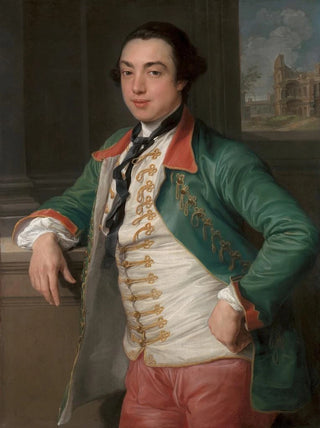Art print | James Caulfeild, Fourth Viscount Charlemont, later First Earl of Charlemont - Pompeo Batoni


View from behind

Frame (optional)
James Caulfeild, Fourth Viscount Charlemont, later Earl of Charlemont - Pompeo Batoni – Captivating Introduction
The masterful artwork by Pompeo Batoni, depicting James Caulfeild, Fourth Viscount Charlemont, is a true window into the 18th century. This portrait, imbued with dignity and refinement, evokes not only the stature of its subject but also the artistic elegance of its era. By contemplating this art print, the viewer is transported to a world where aristocracy intertwines with art, where every detail tells a story. Charlemont's serene face, adorned with sumptuous clothing, embodies the values of his time while inviting reflection on the role of art in representing power and nobility.
Style and uniqueness of the work
Batoni's style is distinguished by its ability to combine striking realism with a certain idealization. In this portrait, the features of James Caulfeild are rendered with meticulous precision, while the background, delicately blurred, highlights the central figure. Light plays a crucial role, illuminating the viscount's face to create an atmosphere of nobility. The drapes of his attire, carefully painted, seem almost tangible, demonstrating the artist's technical mastery. This blend of realism and idealization is characteristic of the rococo style, where elegance and grace prevail. The composition, both balanced and dynamic, draws the eye and invites prolonged contemplation.
The artist and his influence
Pompeo Batoni, born in Lucca in 1708, established himself as one of the most prominent portraitists of his time. His career, marked by prestigious commissions from European nobility, attests to his undeniable talent. Batoni captured the essence of his subjects with such finesse that he influenced many contemporary and later artists. His innovative approach to portraiture paved the way for a new way of representing aristocracy, blending intimacy and grandeur. By integrating elements of classical culture while remaining rooted in his time, Batoni created a visual language that continues to

Matte finish

View from behind

Frame (optional)
James Caulfeild, Fourth Viscount Charlemont, later Earl of Charlemont - Pompeo Batoni – Captivating Introduction
The masterful artwork by Pompeo Batoni, depicting James Caulfeild, Fourth Viscount Charlemont, is a true window into the 18th century. This portrait, imbued with dignity and refinement, evokes not only the stature of its subject but also the artistic elegance of its era. By contemplating this art print, the viewer is transported to a world where aristocracy intertwines with art, where every detail tells a story. Charlemont's serene face, adorned with sumptuous clothing, embodies the values of his time while inviting reflection on the role of art in representing power and nobility.
Style and uniqueness of the work
Batoni's style is distinguished by its ability to combine striking realism with a certain idealization. In this portrait, the features of James Caulfeild are rendered with meticulous precision, while the background, delicately blurred, highlights the central figure. Light plays a crucial role, illuminating the viscount's face to create an atmosphere of nobility. The drapes of his attire, carefully painted, seem almost tangible, demonstrating the artist's technical mastery. This blend of realism and idealization is characteristic of the rococo style, where elegance and grace prevail. The composition, both balanced and dynamic, draws the eye and invites prolonged contemplation.
The artist and his influence
Pompeo Batoni, born in Lucca in 1708, established himself as one of the most prominent portraitists of his time. His career, marked by prestigious commissions from European nobility, attests to his undeniable talent. Batoni captured the essence of his subjects with such finesse that he influenced many contemporary and later artists. His innovative approach to portraiture paved the way for a new way of representing aristocracy, blending intimacy and grandeur. By integrating elements of classical culture while remaining rooted in his time, Batoni created a visual language that continues to






